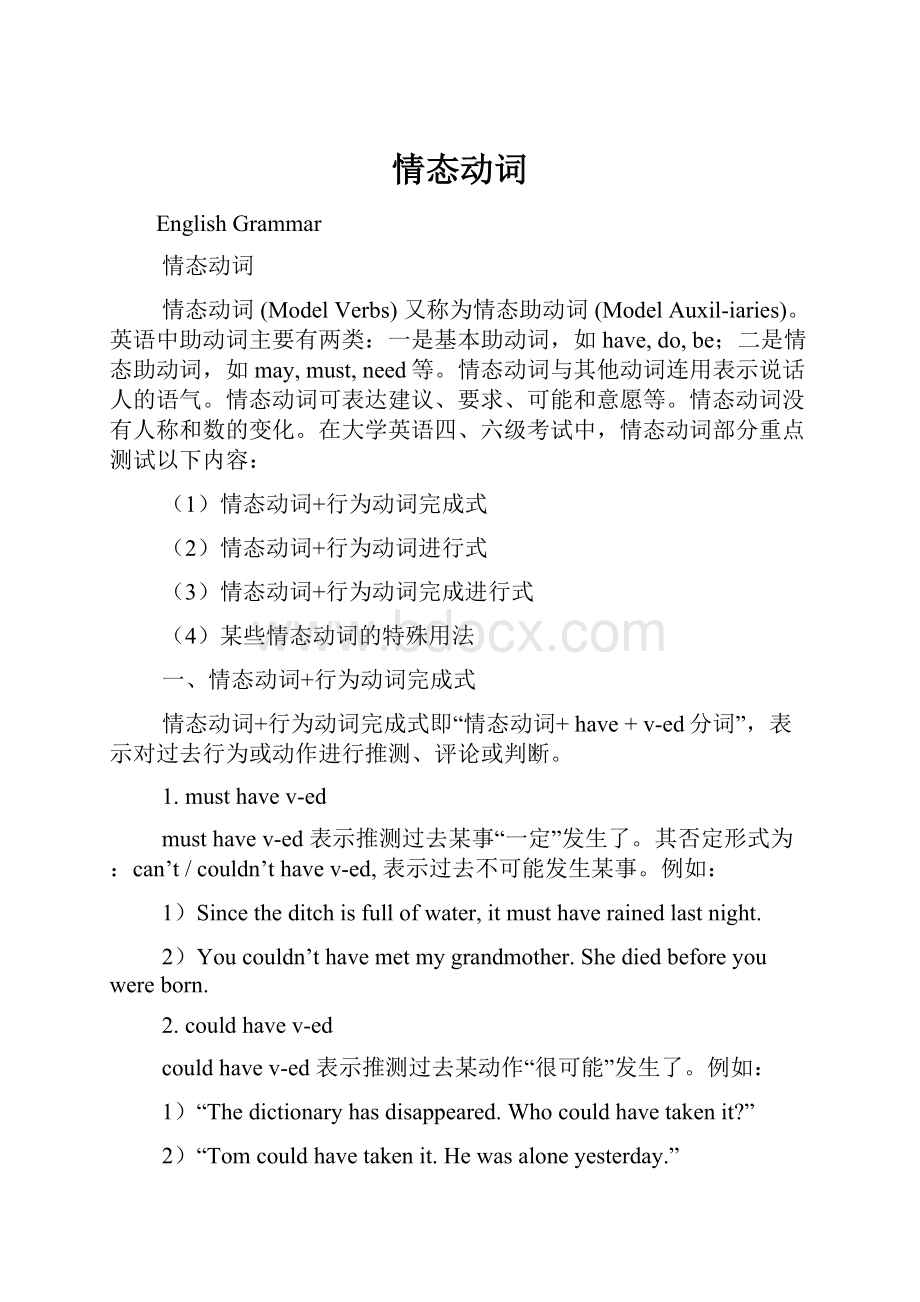情态动词.docx
《情态动词.docx》由会员分享,可在线阅读,更多相关《情态动词.docx(20页珍藏版)》请在冰豆网上搜索。

情态动词
EnglishGrammar
情态动词
情态动词(ModelVerbs)又称为情态助动词(ModelAuxil-iaries)。
英语中助动词主要有两类:
一是基本助动词,如have,do,be;二是情态助动词,如may,must,need等。
情态动词与其他动词连用表示说话人的语气。
情态动词可表达建议、要求、可能和意愿等。
情态动词没有人称和数的变化。
在大学英语四、六级考试中,情态动词部分重点测试以下内容:
(1)情态动词+行为动词完成式
(2)情态动词+行为动词进行式
(3)情态动词+行为动词完成进行式
(4)某些情态动词的特殊用法
一、情态动词+行为动词完成式
情态动词+行为动词完成式即“情态动词+have+v-ed分词”,表示对过去行为或动作进行推测、评论或判断。
1.musthavev-ed
musthavev-ed表示推测过去某事“一定”发生了。
其否定形式为:
can’t/couldn’thavev-ed,表示过去不可能发生某事。
例如:
1)Sincetheditchisfullofwater,itmusthaverainedlastnight.
2)Youcouldn’thavemetmygrandmother.Shediedbeforeyouwereborn.
2.couldhavev-ed
couldhavev-ed表示推测过去某动作“很可能”发生了。
例如:
1)“Thedictionaryhasdisappeared.Whocouldhavetakenit?
”
2)“Tomcouldhavetakenit.Hewasaloneyesterday.”
3.may/mighthavev-ed
may/mighthavev-ed表示推测过去某事“也许”发生了.may比might表示的可能性在说话人看来稍大些。
例如:
Ican’tfindmykeys.Imay/mighthaveleftthemattheschoolyesterday.
4.oughtto/shouldhavev-ed和oughtnotto/shouldn’thavev-ed
oughtto/shouldhavev-ed和oughtnotto/shouldn’thavev-ed用于对已发生的情况表示“责备”、“不满”,分别表示“本应该…”和“本不应该…”。
例如:
1)Withalltheworkfinished,Ishouldhavegonetothepartylastnight.
2)Yououghtnottomakefunofhim.Heisnottheoneyoulaughatbutlearnfrom.
5.needn’thavev-ed
needn’thavev-ed表示过去做了某事,但没有做的必要,意为“本没必要…”。
例如:
Youneedn’thavewakenmeup;Idon’thavetogotoworktoday.
注:
表示推测过去某动作发生的可能性时,就表示的可能性程度而言,must最大,could其次,may更次之,might最小。
例如:
“IwonderhowTomknewaboutyourpast.”
“Hemust/could/may/mighthaveheardofitfromMary.”
二、情态动词+行为动词进行式
情态动词+行为动词进行式(即情态动词+be+v-ing形式),表示推测或评论某动作现在是否正在进行。
例如:
1)Hemustbeplayingbasketballintheroom.
2)Shemaybestayingathome.
三、情态动词+行为动词完成进行式
情态动词+行为动词完成进行式(即情态动词+havebeen+v-ing形式),表示推测或评论过去某动作是否正在进行或一直在进行。
例如:
1)Theyshouldhavebeenmeetingtodiscusstheproblem.
2)Hemay/mighthavebeenbuyingstampsinthepostofficewhenyousawhim.
四、某些情态动词的特殊用法
1.need
考试中主要测试need作情态动词与作实义动词的区别,对此,可参见表1.need作情态动词时,后面跟不带to的动词不定式,即“needto”。
通常用在疑问句和否定句中,表示询问是否有“必要”,其否定形式为needn’t,表示“不必”;疑问形式为Need…do?
极少用于肯定句。
例如:
1)Idon’tthinkweneedturnthelightonatthattime.
2)Needyourideabiketoschool?
情态动词need与实义动词need在时态、肯定、否定结构上的对比见表1。
2.dare
考试中主要测试dare作情态动词和作实义动词的区别。
情态动词dare与实义动词dare在时态、肯定、否定、疑问结构上的对比见表2。
3.can和may
考试中主要测试can,may或could,might表示可能性的区别及对may构成的疑问句的回答。
时态情态动词need实义动词need
现Youneed(not)doYou(don’t)needtodo
在
时Heneed(not)doHeneeds(doesn’tneed)todo
过Youneeded(didn’tneed)todo
去
时Heneeded(didn’tneed)todo
将Youneed(not)doYouwill(not)needtodo
来
时Heneed(not)doHewill(not)needtodo
句型时态动词
情态动词dare实义动词dare
肯定句现在时dareto少用dare/darestodo
过去时dareto少用daredtodo
否定句现在时daren’t/darenotdodo/doesnotdare(to)do
过去时darednotdodidnotdare(to)do
疑问句现在时Darehedo?
Doyou/Doeshedear(to)do?
过去时Daredhedo?
Didhedare(to)do
(1)can,could,may,might都可以表示可能性.can,could表示潜在的可能性或理论上或逻辑判断上存在的可能性;而may,might则表示事实上的可能性。
此外,can还具有“有能力”的意思,而may与might则不具此意。
例如:
1)Accordingtotheweatherforecast,itmayraintomorrow.
2)Anymanwithalittlesensecanseethatheiswrong.
(2)MayI/we…?
这一类疑问句的肯定回答为Yes,please.或Certainly;否定回答为Pleasedon’t.或No,youmustn’t.例如:
“Mayweleavenow?
”“No,youmustn’t.Youhaven’tfinishedyourhomeworkyet.”
4.can和beableto
can与beableto都可以表示能力,但两者在用法上有点差异:
can(could)表示主观能力,不表示意愿,它的将来时用willbeableto;beableto表示主观意愿,强调要克服困难去做某事。
例如:
1)Mygrandmaisoverseventy,butshecanstillreadwithoutglasses.
2)Heisabletogiveuphisbadhabits.
5.must和haveto
must和haveto都可以表示“必须”,但有几点区别:
(1)must强调“内在的职责”、“义务”,而haveto强调“外界压力”、“不得已而为之”。
(2)haveto可用于多种时态,而must一般用于现在时,其过去时与将来时分别由hadto与shall/willhaveto代替。
(3)在回答must引起的问题时,如果是否定的答复,不能用mustn’t,而要用needn’t或don’thaveto,因为mustn’t是“一定不要”、“一定不能”的意思。
例如:
1)Youmustcometotheclassroombeforeeight.
2)Itisraininghardoutside,butIhavetoleavenow.
3)“Mustwedoitnow?
”“No,youneedn’t.”
6.usedto+v,beusedto+v-ing和beusedto+v
(1)usedto+v意为“过去常常”,“过去一直”;beusedto+v-ing/n(名词)意为“习惯于”;beusedto+v意为“被用来(做某事)”。
(2)usedto只表示过去,而beusedto+v-ing/n可表示现在、过去或将来。
例如:
1)Heusedtosmoke.Nowhedoesn’t.
2)He’squiteusedtohardwork/workinghard.
3)Theknifeisusedtocutbread.
7.用作情态动词的其他短语
wouldrather,wouldsooner,would(just)assoon,hadrather,hadbetter,hadsooner,cannotbut,may(just)aswell等可用作情态动词。
例如:
1)Thesoldierwouldsoonerdiethansurrender.
2)Thebravesoldierwouldassoondieasyieldtosuchanenemy.
3)I’dratherwalkthantakeabus.
4)Ifyoudon’tliketoswim,youmayjustaswellstayathome.
注:
这些短语后一般直接跟动词原形.would(had)rather,would(had)sooner,would(just)assoon后可跟that引导的从句,that常省去,从句要用虚拟语气。
对现在和将来的假设用过去时,对过去的假设用过去完成时。
例如:
1)IwouldratheryoucameonSunday.
2)Iwouldsooneryouhadn’taskedmetospeakyesterday.
、考查can的用法
a.考查can表示能力的用法。
在这一用法中,can表示能力,意思是"能,会",其否定式can't表示"不能"。
在过去时中用could和couldn't。
例如:
1.-Where'sMrLee?
Ihavesomethingunusualtotellhim.
-You________findhim.He________Japan.(2003黑龙江)
A.maynot;hasgonetoB.maynot;hasbeento
C.can't;hasgonetoD.can't;hasbeento
2.-Finishdrawingahorseintenminutes.OK?
-Sorry.It________insuchashorttime.(2003山东威海)
A.maydoB.can'tbedone
C.mustdoD.needn'tbedone
3.Ihavemyownroominmyhouse,soI________dowhatIwantinit.(2002江西)
A.mustB.havetoC.needtoD.can
4.________youmendmycar?
I______notstartit.(2002常德市)
A.Would;wouldB.Must;mustC.Can;canD.May;may
5.________sheridewhenshewasthreeyearsold?
(2002长沙市)
A.CanB.CouldC.NeedD.May
6.Theboy________answerthiskindofhardquestionsoneyearago.(2002四川省)
A.canB.mayC.could
Answers:
1.C2.B3.D4.C5.B6.C
b.考查can表示推测的用法。
在这一用法中,can意为"可能",表示客观可能性,常常用于疑问句和否定句中。
例如:
7.Whoisthemanoverthere?
IsitMrLi?
-No,it________behim.MrLiismuchtaller.(2003河北)
A.mustn'tB.maynotC.can'tD.needn't
8.-Listen!
Someoneissinginginthenextroom.Who________itbe?
IsitWeiFang?
-No.It________beher.Sheisatschoolnow.(2002重庆市)
A.will;maynotB.must;mustn'tC.may;can'tD.may;won't
9.-IsMrHuinthereadingroom?
-No,he________bethere.HehasgonetoTianjin.(2002新疆)
A.mustn'tB.needn'tC.won'tD.can't
10.Class3wonthefootballmatch!
________itbetrue?
(2002广东)
A.MayB.MustC.WillD.Can
Answers:
7.C8.C9.D10.D
c.考查can/could表示请求许可的用法?
在这一用法中,can和could都表示现在,用could比用can语气更加委婉客气,常用CouldI/you...?
句式,表示"我/你能……吗?
"若表示同意要用can,不用could?
例如:
11.-CouldIlookatyourpictures?
-Yes,ofcourseyou________.(2003武汉)
A.couldB.canC.willD.might
12.________youpassmeapen?
I'dliketowritedownthetelephonenumber.(2002北京市海淀区)
A.NeedB.Could C.MustD.Should
Answers:
11.B12.B
二、考查must的用法
a.考查must表示义务的用法。
在这一用法中,must意为"必须","应该",表示必须要做的事,其否定式mustn't表示禁止,即不许对方做某事?
例如:
13.-MayIgotothecinema,Mum?
-Certainly.Butyou________bebackby11o'clock.(2003安徽)
A.canB.mayC.mustD.need
14.-SARSissuchaterribledisease.
-Yes,itis.We________bemorecareful.(2003浙江嘉兴)
A.canB.mayC.mustD.need
15.Tomakeourcitymorebeautiful,rubbish________intotheriver.(2003重庆)
A.needn'tbethrown B.mustn'tbethrown
C.can'tthrow D.maynotthrow
16.Thesebooks________outofthereadingroom.Youhavetoreadthemhere.(2003辽宁)
A.can'ttakeB.mustbetaken C.cantakeD.mustn'tbetaken
17.Cars,busesandbikes________stopwhentrafficlightschangetored.(2002上海市)
A.canB.mayC.mustD.need
Answers:
13.C14.C15.B16.D17.C
要注意must和haveto的用法区别?
must表示说话人的主观看法,而haveto表示客观的需要,意思是"不得不"?
例如:
18.-Canyougoswimmingwithusthisafternoon?
-Sorry,Ican't.I________takecareofmylittlesisterathomebecausemymotherisill.
(2003南京)
A.canB.may C.wouldD.haveto
Answer:
18.D
回答must开头的一般疑问句,如果是否定的回答,要用needn't或don'thaveto,表示"不必","没有必要"的意思,不用mustn't,因为mustn't表示禁止或不许,意思是"一定不要"的意思。
例如:
19.-MustIfinishtheworkbeforefiveo'clock?
-No,you________.(2003四川)
A.needn'tB.mustn'tC.haveto
20.-________Icomebackbeforefiveo'clock?
-No,you________.Butyou________bebacklaterthanseveno'clock.(2002烟台市)
A.Need;must;mustn't B.May;mustn't;can't
C.Can;can't;can't D.Must;needn't;can't
21.-MustIcleantheroomrightnow?
-No,you________.You________cleanitafterlunch.(2002徐州市)
A.needn't;can B.needn't;may
C.mustn't;canD.mustn't;may
Answers:
19.A20.D21.B
b.考查must表示推测的用法。
在这一用法中,must意为"一定","肯定",表示可能性很大,通常用于肯定句,在否定句中要用can't,表示"不可能"。
例如:
22.Susan'sparentshaveboughtalargehousewithaswimmingpool.It____beveryexpensive.(2003上海)
A.mustB.canC.mustn'tD.can't
23.Thisbook________Lucy's.Look!
Hernameisonthebookcover.(2002河南)
A.mustbeB.maybe C.can'tbeD.mustn'tbe
Answers:
22.A23.A
三、考查may的用法
a.考查may表示请求许可的用法
在这一用法中,may表示许可或征询对方许可,表示"可以"的意思,常常与第一人称I连用,构成MayI...?
句式,表示"我可以……吗?
"肯定回答用Yes,youmay.;Yes,please.等;否定回答用No,youcan't.或No,youmustn't.,不用No,youmaynot.?
例如:
25.-________Ihaveyourname,please?
-Yes,Michael.M-I-C-H-A-E-L.(2002北京市东城区)
A.MustB.WillC.MayD.Need
26.-MayIgotothecinema,dad?
-No,you________.Youmustfinishyourhomeworkfirst.(2002浙江金华市)
A.mustn'tB.won't C.don'tD.needn't
27.-MayIsmokehere?
-________,you________.Itcanbedangerous.(2002滨州市)
A.Yes;canB.